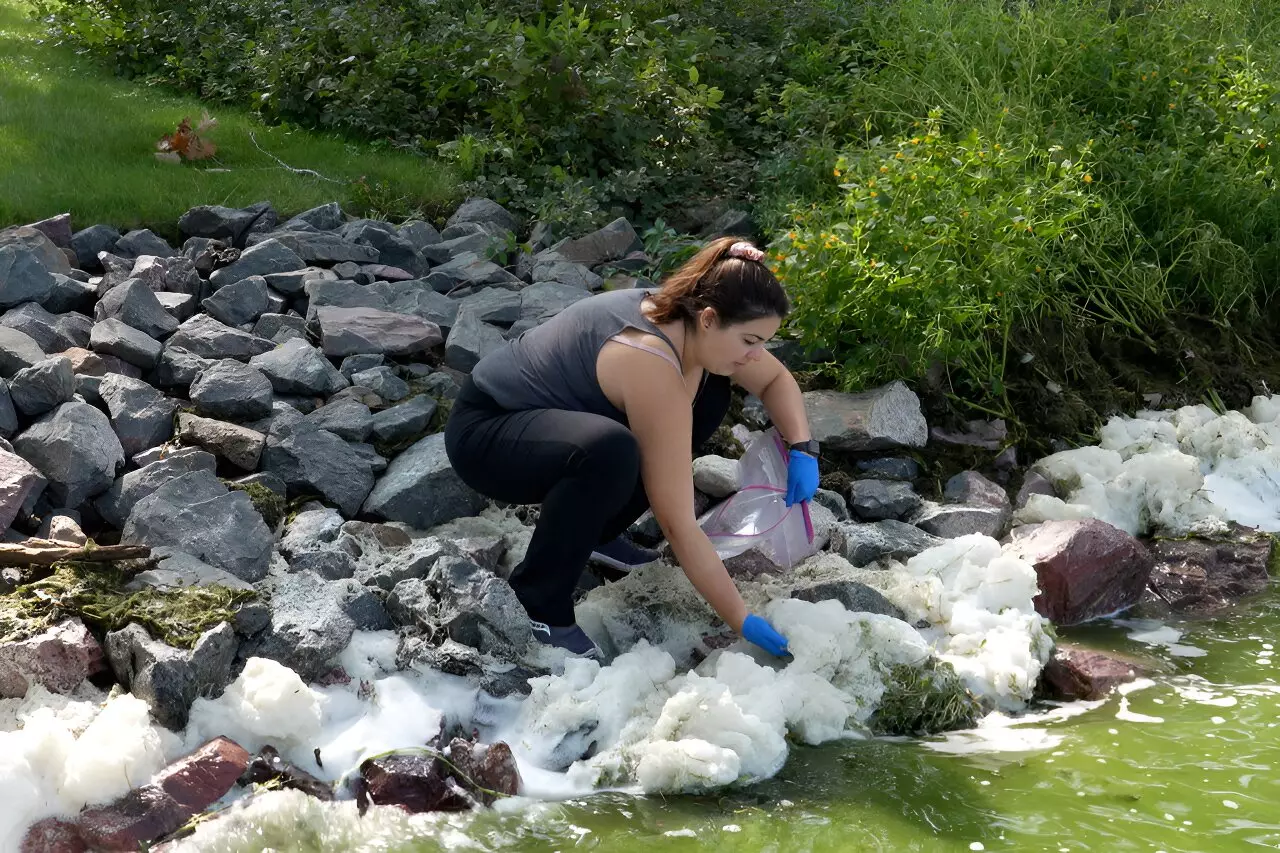A recent study conducted on the aquatic ecosystems of Wisconsin has unveiled significant insights concerning the presence of per- and polyfluoroalkyl substances (PFAS) in natural foams found on rivers and lakes. This research, published in the reputable journal Environmental Science & Technology, indicates that the foams, which often appear as innocuous off-white layers lining shorelines, may contain PFAS concentrations far exceeding those found in the underlying water. The analysis, which examined a staggering thirty-six different PFAS compounds across samples taken from 43 bodies of water, fundamentally shifts our understanding of contamination sources lurking within these natural settings.
The study’s lead researcher, Christy Remucal, from the University of Wisconsin–Madison, highlighted an unsettling finding: all investigated lakes exhibited PFAS presence, with foam concentrations sometimes approaching alarming levels. Notably, some samples reached a shocking 300,000 nanograms per liter for PFOS, a commonly referenced PFAS compound associated with stringent fish advisories and drinking water standards. In stark contrast, federal regulations cap PFOS levels in drinking water at a mere 4 nanograms per liter. This dramatic disparity raises critical questions about public safety, particularly in areas frequented by families and pets during warmer months.
The Invisibility of PFAS Contamination
The dire implications of this study transcend mere scientific curiosity; they constitute a pressing public health challenge. The foams, while visually unremarkable, serve as concentrated repositories of contaminants that could easily go unnoticed by the untrained eye. Remucal issued a clear warning against the dangers of engaging with these foams, cautioning that indirect ingestion—such as a child who plays in the foam and subsequently eats snacks—could pose health risks. This emphasizes the need for public awareness and education regarding the potential health risks associated with recreational activities around affected water bodies.
As we ponder the ramifications, it becomes evident that PFAS, often dubbed “forever chemicals,” do not simply vanish. With over 9,000 distinct PFAS compounds in existence, their legacy of contamination continues to accumulate in our environment. Their resistance to environmental degradation makes them particularly menacing; once introduced, they can persist indefinitely, raising the stakes for both environmental cleanup efforts and human health considerations.
A Call for Community Engagement and Action
Integral to the success of this research were the contributions of citizen volunteers and the Wisconsin Department of Natural Resources, which played a critical role in identifying areas for sampling. This community-driven approach underscores a vital lesson: tackling PFAS contamination requires collaboration between scientists, policymakers, and engaged citizens. As more individuals become aware of the risks associated with PFAS, the potential for collective action increases. Local communities must advocate for increased transparency around water quality and make noise about contaminants that threaten their health and the environment.
The study findings also correlate with existing advisories from the Wisconsin Department of Natural Resources and similar alerts issued in Michigan and the Netherlands. The timing of these warnings is crucial; as warmer weather approaches, outdoor recreation becomes increasingly popular, lending urgency to the research aims. As more people and their pets engage in activities near affected waters, it’s imperative to disseminate this information effectively to mitigate potential exposure.
Understanding PFAS Movement and Future Cleanup Efforts
Beyond the immediate public health implications, the research presents a framework for understanding PFAS dynamics in aquatic ecosystems. One critical aspect of the study involved examining surface microlayers, revealing that PFAS concentrations were also elevated—though not as drastically—as compared to the water below. This has significant implications for how we comprehend the journey of PFAS as they migrate within both surface and groundwater systems.
Moreover, this pioneering research fuels ongoing discussions about potential remediation strategies for PFAS contamination. Given that PFAS compounds act as surfactants, their affinity for air-water interfaces suggests that innovative cleanup methods could focus on removing contaminants from foam bubbles. Scientists now have new pathways to explore in their quest for sustainable cleanup solutions in heavily contaminated areas.
The battle against PFAS contamination is far from over, yet the findings from Wisconsin offer hope. By fostering a culture of awareness and advocacy within local communities, we can bring to light these hidden dangers lurking in our water bodies, turning knowledge into action that protects both public health and our invaluable natural resources.

